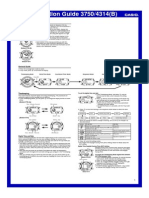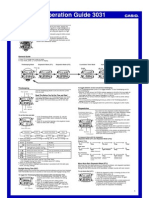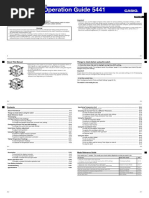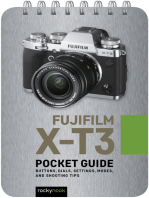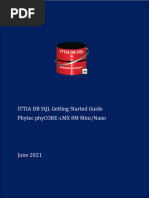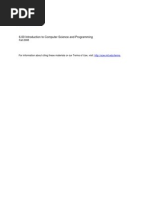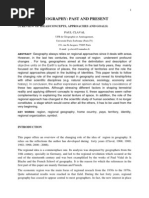QW 4335
QW 4335
Uploaded by
doombuggyCopyright:
Available Formats
QW 4335
QW 4335
Uploaded by
doombuggyOriginal Description:
Original Title
Copyright
Available Formats
Share this document
Did you find this document useful?
Is this content inappropriate?
Copyright:
Available Formats
QW 4335
QW 4335
Uploaded by
doombuggyCopyright:
Available Formats
MO0607-EB
Operation Guide 4335 4348
Getting Acquainted
Congratulations upon your selection of this CASIO watch. To get the most out of your
purchase, be sure to read this manual carefully.
About This Manual
Depending on the model of your watch, display text
appears either as dark figures on a light background
(Module 4335), or light figures on a dark background
(Module 4348). All sample displays in this manual are
shown using dark figures on a light background.
Button operations are indicated using the letters shown
in the illustration.
For the sake of simplicity, the sample displays in this
manual do not show the analog hands of the watch.
Each section of this manual provides you with the
information you need to perform operations in each
mode. Further details and technical information can be
found in the Reference section.
(Light)
Warning!
The measurement functions built into this watch are not intended for use in taking
measurements that require professional or industrial precision. Values produced
by this watch should be considered as reasonably accurate representations only.
The longitude, lunitidal interval, Moon phase indicator and tide graph data that
appear on the display of this watch are not intended for navigation purposes.
Always use proper instruments and resources to obtain data for navigation
purposes.
This watch is not an instrument for calculating low tide and high tide times. The
tide graph of this watch is intended to provide a reasonable approximation of tidal
movements only.
CASIO COMPUTER CO., LTD. assumes no responsibility for any loss, or any
claims by third parties that may arise through the use of this watch.
Module 4335
Module 4348
General Guide
Temperature Data
Recall Mode
Press C to change from mode to mode.
In any mode, press L to illuminate the display.
Tide/Moon Data Mode
Press C.
Timekeeping Mode
Stopwatch Mode
World Time Mode
Countdown Timer
Mode
Alarm Mode
Hand Setting Mode
Timekeeping
Use the Timekeeping Mode to set and view the current time and date.
This watch features separate digital and analog timekeeping. The procedures for
setting the digital time and analog time are different.
In the Timekeeping Mode, press A to toggle between the thermometer screen and
the temperature tendency screen.
Temperature Tendency
Thermometer Screen
Screen
Thermometer
Moon
phase
indicator
Screen:
Temperature
Tendency
Graph
Press A.
Tide
graph
3. When the setting you want to change is flashing, use D and B to change it as
described below.
Day of week
Day
Hour : Minutes Seconds
llll
llll
lll
Temperature
Unit
DST
UTC
Differential
Temperature Sensor
Calibration
Hour
Day
Minutes
Month
12/24-Hour
Format
Year
The UTC differential setting range is 12.0 to +14.0, in 0.5-hour units.
For information about settings other than the time and date, see the following.
Temperature Sensor Calibration: Thermometer
Temperature Unit: Thermometer
4. Press A twice to exit the setting screen.
The 12-hour/24-hour timekeeping format you select in the Timekeeping Mode is
applied in all modes.
The day of the week is displayed automatically in accordance with the date (year,
month, and day) settings.
When DST is turned on, the UTC differential setting range is 11.0 to +15.0, in 0.5hour units.
Any time the seconds setting is changed, the analog hands are adjusted accordingly.
See Daylight Saving Time (DST) Setting below for details about the DST setting.
Daylight Saving Time (DST) Setting
Daylight Saving Time (summer time) advances the time setting by one hour from
Standard Time. Remember that not all countries or even local areas use Daylight
Saving Time.
To toggle the Timekeeping Mode digital time between DST and Standard Time
1.In the Timekeeping Mode, hold down A until the
seconds start to flash, which indicates the setting
DST indicator
screen.
l
l
l
l
l
2. Press C once and the DST setting screen appears.
3. Press D to toggle between Daylight Saving Time (ON
displayed) and Standard Time (OF displayed).
ll l
4. Press A twice to exit the setting screen.
The DST indicator appears on the Timekeeping, Tide/
Moon Data, Alarm, and Hand Setting Mode screens to
indicate that Daylight Saving Time is turned on. In the
On/Off status
case of the Tide/Moon Data Mode, the DST indicator
appears on the Tide Data screen only.
llll
Seconds
Use D (+) and B ().
Use D (+) and B ().
ll
To set the digital time and date
1. In the Timekeeping Mode, hold down A until the
seconds start to flash, which indicates the setting
screen.
Be sure to configure the correct UTC differential for
your Home Site before configuring any other
ll l
Timekeeping Mode settings.
See the UTC Differential/City Code List for
information about the UTC differential settings that are
supported.
Seconds
2. Press C to move the flashing in the sequence shown
below to select other settings.
Change the hour or minutes
Change the month or day
ll
This watch is preset with UTC differential values that represent each time zone around
the globe. Before setting the digital time, be sure to first set the UTC differential for
your Home Site, which is the location where you normally will be using the watch.
Note that World Time mode times are all displayed based on the time and date
settings you configure in the Timekeeping Mode.
Press D.
Toggle between 12-hour (12H) and Press D.
24-hour (24H) timekeeping
Use D (+) and B ().
Change the year
llll
Setting the Digital Time and Date
Toggle between Daylight Saving
Time (ON) and Standard Time (OF)
Specify the UTC differential
lll
Important!
Be sure to configure the current time and date, and your Home Site data (data for
the site where you use the watch) correctly before using the functions of this watch.
See Home Site Data for more information.
Do this:
Press D.
lll lll
PM indicator
The tide graph shows tidal movements for the current date in accordance with the
current time as kept in the Timekeeping Mode.
The Moon phase indicator shows the current Moon phase in accordance with the
current date as kept in the Timekeeping Mode.
See Thermometer for details about the thermometer screen and temperature
tendency graph.
To do this:
Reset the seconds to 00
Home Site Data
Moon phase, tide graph data, and Tide/Moon Data Mode data will not be displayed
properly unless Home Site data (UTC differential, longitude and lunitidal interval) is
configured correctly.
The UTC differential indicates the time differential with Greenwich, England.
The letters UTC is the abbreviation for Coordinated Universal Time, which is the
world-wide scientific standard of timekeeping. It is based upon carefully maintained
atomic (cesium) clocks that keep time accurately to within microseconds. Leap
seconds are added or subtracted as necessary to keep UTC in sync with the Earths
rotation.
Operation Guide 4335 4348
To specify a date
lll
Lunitidal Interval
Hours
1. In the Tide/Moon Data Mode, hold down A until the
year setting starts to flash, which indicates the setting
screen.
2. Press C to move the flashing in the sequence shown
below to select the other settings.
llllllll
l l llll
Longitude
(East/West)
lllll
Longitude
Value
lll
ll
lll
To view tide data for a particular time
1. In the Tide/Moon Data Mode, press A to display the Tide Data screen.
The initial screen shows the tide graph for 6:00 AM.
2. Use D (+) and B () to display the time whose Tide Data you want to view.
lll
To configure Home Site data
1. In the Timekeeping Mode, hold down A until the
seconds start to flash, which indicates the setting
screen.
2. Press C once to display the UTC differential setting
screen, and confirm that the setting is correct.
lll l l lll
If the UTC differential setting is not correct, use D (+)
and B () to change it.
3. Press A to display the longitude value setting screen.
Longitude
4. Press C to move the flashing in the sequence shown
Longitude
(East/West)
Value
below to select other settings.
To view the Moon data for a particular date
1. In the Tide/Moon Data Mode, press A to display the Moon Data screen.
2. Use D (+) and B () to display the date whose Moon Data you want to view.
You can select any date from 2000 to 2099.
You can also specify a date for tide data or Moon data. For details, see To specify a
date.
lll
The lunitidal interval is the time elapsing between the Moons transit over a meridian
and the next high tide at that meridian. See Lunitidal Interval for more information.
This watch displays lunitidal intervals in terms of hours and minutes.
The Site/Lunitidal Interval Data List provides UTC differential and longitude
information around the world.
The following is the initial factory default Home Site data (Tokyo, Japan) when you
first purchase the watch and whenever you have the batteries replaced. Change
these settings to match the area where you normally use the watch.
UTC differential (+9.0); Longitude (East 140 degrees); Lunitidal interval (5 hours,
20 minutes)
Year
Year
5. While the setting you want to change is flashing, use D and B to change it as
described below.
Screen
Button Operations
Use D (+) and B () to change the setting.
You can specify a value from 0 to 180, in 1degree units.
Longitude
(East/West)
Use D to switch between east longitude (E)
Lunitidal Interval
Hours, Minutes
Use D (+) and B () to change the setting.
and west longitude ( ).
6. Press A to exit the setting screen.
Thermometer
This watch uses a temperature sensor to measure temperature. A reading is taken
during each even-numbered minute, and the result of the last reading is displayed on
the thermometer screen.
The watch also takes separate readings and stores them in memory for display in the
temperature tendency graph, which can be viewed in the Timekeeping Mode.
Measured temperature values are stored in memory for later recall when you need
them.
Temperature
Thermometer Screen
Tendency Screen Temperature
Press A.
Thermometer
Perform the procedure below when the time indicated by the analog hands does not
match the time of the digital display.
Tendency
Graph
Setting the Analog Time
Setting
Day
3. While a setting is flashing, use D (+) or B () to
change it.
You can specify a date in the range of January 1,
2000 to December 31, 2099.
4. Press A to exit the setting screen.
5. Use A to display either the Tide Data screen or the
Moon Data screen.
Lunitidal Interval
Minutes
Longitude Value
Month
Month Day
llll lll
lll l l lll
To lock high speed hands movement, hold down D to start it and then press B
to lock. The hands will continue to advance for one 12-hour cycle or until you
press any button to stop it.
It will also stop automatically after the time advances 12 hours or if an alarm (daily
alarm, Hourly Time Signal, or countdown beeper) starts to sound.
4. Press A to exit the setting screen.
The minute hand will be adjusted slightly to match the seconds when you exit the
setting screen.
To return to the Timekeeping Mode, press C.
Tide/Moon Data
Tide graph
Month Day
Time
Moon Phase Indicator
Tide/Moon data lets you view the Moon age and the Moon
phase for a particular date, and tidal movements for a
particular date and time for your Home Site.
When you enter the Tide/Moon Data Mode, the data for
6:00 a.m. on the current date appears first.
If you suspect that the Tide/Moon data is not correct for
some reason, check the Timekeeping Mode data
(current time, date, and Home Site settings), and make
changes as required.
See Moon Phase Indicator for information about the
Moon phase indicator and Tide Graph for information
about the tide graph.
All of the operations in this section are performed in the
Tide/Moon Data Mode, which you enter by pressing C.
Tide/Moon Data Screens
In the Tide/Moon Data Mode, press A to toggle between the Tide Data screen and
the Moon Data screen.
Tide Data Screen
Moon Data Screen
Tide graph
Moon phase indicator
Press A.
You can select either Celsius (C) or Fahrenheit (F) units for the thermometer
screen. See To specify the temperature display unit for more information.
The thermometer screen displays temperature values in 0.1C units (or 0.2F units).
The display range of the thermometer screen is 10.0C to 60.0C (or 14.0F to
140.0F).
You can calibrate the temperature sensor if you feel that the displayed temperature
values are not correct. See Temperature Sensor Calibration for more information.
Important!
Temperature measurements are affected by your body temperature (while you are
wearing the watch), direct sunlight, and moisture. To achieve a more accurate
temperature measurement, remove the watch from your wrist, place it in a well
ventilated location out of direct sunlight, and wipe all moisture from the case. It takes
approximately 20 to 30 minutes for the case of the watch to reach the actual
surrounding temperature.
Temperature Tendency Graph
The watch also takes temperature readings at the top and the bottom of each hour
and stores the results in memory for display on the temperature tendency graph.
Depending on the current Timekeeping Mode time, the temperature tendency graph
shows either the top of the hour measurements or the bottom of the hour
measurements for the past 17 hours.
From the top of each hour to the 29th minute, past top of the hour readings are shown
in the graph. From the bottom of each hour to the 59th minute, past bottom of the hour
readings are shown in the graph.
Temperature tendency graph contents are updated every 30 minutes.
+6.0 to +9.9C (+10.8 to +17.9F)
+2.0 to +5.9C (+3.6 to +10.7F)
1.9 to +1.9C (3.5 to +3.5F)
5.9 to 2.0C (10.7 to 3.6F)
9.9 to 6.0C (17.9 to 10.8F)
1. In the Timekeeping Mode, press C seven times to
enter the Hand Setting Mode.
2. Hold down A until the current digital time starts to
flash, which indicates the setting screen.
3. Use D to adjust the analog setting.
Press D once to advance the hands 20 seconds.
Hold down D to advance the hands at high speed.
lll
lll
To adjust the analog time
Past 17 hours of
measurement values
Temperature change greater
than +10.0C (+18.0F)
Month Day
Latest measurement value
The horizontal axis of the graph represents time. The rightmost column is the newest
temperature value in memory, while the leftmost column is the temperature value
stored approximately 17 hours ago (1 dot = 1 hour). The vertical axis of the graph
represents the relative change from one hour to the next.
When the relative change from one hour to the next exceeds +10.0C (+18.0F), the
dot at the highest point for the applicable hour flashes.
When the relative change from one hour to the next exceeds 10.0C (18.0F),
there is no dot in the applicable hour's column.
If a measurement error occurs for some reason, only a single the dot in the center
column will be displayed.
Temperature change greater
than 10.0C (18.0F)
Error
ll
Moon age
ll
Time
lll
ll
When you enter the Tide/Moon Data Mode, the data that appears first is the Moon
data (Moon age and Moon phase indicator) for the current date as kept by the
Timekeeping Mode.
Operation Guide 4335 4348
Alarm
Alarm time
(Hour : Minutes)
Recalling Temperature Data
Data storage time
Alarm on indicator
When the alarm is turned on, the watch beeps when the
alarm time is reached. You can also turn on an Hourly
Time Signal, which will cause the watch to beep twice
every hour on the hour.
All of the operations in this section are performed in the
Alarm Mode, which you enter by pressing C.
Hourly time signal
on indicator
To set the alarm time
llll
1. In the Alarm Mode, hold down A until the hour setting
of the alarm time starts to flash, which indicates the
setting screen.
This operation turns on the alarm automatically.
2. Press C to move the flashing between the hour and
ll
minute settings.
3. While a setting is flashing, use D (+) and B () to
change it.
When setting the alarm time using the 12-hour format, take care to set the time
correctly as a.m. (A indicator) or p.m. (P indicator).
4. Press A to exit the setting screen.
llll
To recall temperature records
1. In the Timekeeping Mode, press C twice to enter the
Temperature
Temperature Data Recall Mode.
Record
This displays the newest record currently in memory.
Number 2. Use D (+) and B () to scroll through the records.
Pressing D while the oldest record is displayed will
scroll to the newest record.
If a temperature measurement operation is performed
while a record is displayed, the displayed record's
number will be incremented by 1.
If an error occurs during temperature measurement,
--.- will be shown for the temperature value in the
corresponding record.
AM indicator
ll
The measurements the watch takes at the top and the bottom of each hour are stored
in memory automatically. Memory can hold up to 50 measurement records. You can
use the Temperature Data Recall Mode to recall memory data when you need it.
Temperature data records are assigned numbers automatically starting from 01.
When there are already 50 records in memory, storage of a new temperature
reading causes the oldest record (record number 50) to be deleted automatically to
make room for the new data. The new data is assigned record number 1, and all of
the numbers of all the other records (01 to 49) are incremented by 1 (becoming 02
through 50).
Alarm Operation
Stopwatch
The stopwatch lets you measure elapsed time, split times,
Minutes
1/100 Second and two finishes.
The display range of the stopwatch is 99 hours, 59
minutes, 59.99 seconds.
The stopwatch continues to run, restarting from zero
after it reaches its limit, until you stop it.
All of the operations in this section are performed in the
Stopwatch Mode, which you enter by pressing C.
The alarm sounds at the preset time for 10 seconds, regardless of the mode the watch
is in.
To stop the alarm tone after it starts to sound, press any button.
To test the alarm
In the Alarm Mode, hold down D to sound the alarm.
To turn the Daily alarm and the Hourly Time Signal on and off
In the Alarm Mode, press D to cycle through the settings shown below.
Module 4335
Seconds
Hours
Alarm Off
Signal Off
Alarm On
Signal Off
Alarm Off
Signal On
Alarm On
Signal On
Alarm Off
Signal Off
Alarm On
Signal Off
Alarm Off
Signal On
Alarm On
Signal On
To measure times with the stopwatch
Module 4348
Elapsed Time
D
Start
D
Stop
D
Re-start
D
Stop
A
Clear
A
Split
A
Split release
D
Stop
A
Clear
D
Stop
A
Split release
A
Clear
Split Time
D
Start
The alarm on indicator and the Hourly Time Signal on indicator are shown on the
display in all modes while these functions are turned on.
(SPL displayed)
Two Finishes
D
World Time
A
Split
Start
First runner
finishes.
Display time of
first runner.
Second runner
finishes.
Display time of
second runner.
Day of the week and day
in the selected city
Countdown Timer
Hours Minutes
Second
You can set the countdown timer within a range of one
minute to 100 hours. An alarm sounds when the
countdown reaches zero.
You can also select auto-repeat, which automatically
restarts the countdown from the original value you set
whenever zero is reached.
All of the operations in this section are performed in the
Countdown Timer Mode, which you enter by pressing
C.
To use the countdown timer
Press D while in the Countdown Timer Mode to start the countdown timer.
When the end of the countdown is reached and auto-repeat is turned off, the alarm
sounds for 10 seconds or until you stop it by pressing any button. The countdown
time is automatically reset to its starting value after the alarm stops.
When auto-repeat is turned on, the countdown will restart automatically without
pausing when it reaches zero. The alarm sounds to signal when the countdown
reaches zero.
The countdown timer measurement operation continues even if you exit the
Countdown Timer Mode.
To stop a countdown operation completely, first pause it (by pressing D), and then
press A. This returns the countdown time to its starting value.
llll
llll
To configure countdown start time and auto-repeat settings
1. While the countdown start time is on the display in the
Countdown Timer Mode, hold down A until the hour
Auto-repeat on indicator
setting of the countdown start time starts to flash, which
indicates the setting screen.
If the countdown start time is not displayed, use the
procedure under To use the countdown timer to
ll l
display it.
2. Press C to move the flashing in the sequence shown
below, and select the setting you want to change.
lll
On/Off status
Start Time
(Hours)
Start Time
(Minutes)
Auto-Repeat
On/Off
3. Perform the following operations, depending on which setting is currently selected
on the display.
While the start time setting is flashing, use D (+) and B () to change it.
Set 0:00 to specify 100 hours.
While the auto-repeat on/off setting (0N or 0F) is flashing on the display, press
D to toggle auto-repeat on (0N) and off (0F).
4. Press A to exit the setting screen.
The auto-repeat on indicator (
) is displayed on the Countdown Timer Mode
screen while this function is turned on.
Frequent use of auto-repeat and the alarm can run down battery power.
City code
Current time in
selected city
The World Time Mode digitally displays the current time in
50 cities (30 time zones) around the world.
The times kept in the World Time Mode are
synchronized with the time being kept in the
Timekeeping Mode. If you feel that there is an error in
any World Time Mode time, check the UTC differential of
your Home Site Data (Home City) and the current
setting of the Timekeeping Mode time.
Select a city code in the World Time Mode to display the
current time in any particular time zone around the
globe. See the UTC Differential/City Code List for
information about the UTC differential settings that are
supported.
All of the operations in this section are performed in the
World Time Mode, which you enter by pressing C.
To view the time in another city
While in the World Time Mode, press D to scroll eastward through the city codes
(time zones) or B to scroll westward.
To toggle a city code time between Standard Time and Daylight Saving Time
1. In the World Time Mode, use D and B to display the
city code (time zone) whose Standard Time/Daylight
Saving Time setting you want to change.
2. Hold down A to toggle between Daylight Saving Time
(DST indicator displayed) and Standard Time (DST
indicator not displayed).
The DST indicator is shown on the World Time screen
while
Daylight Saving Time is turned on.
DST indicator
Note that changing the Daylight Saving Time for any city
code causes the setting to be applied to all city codes.
Illumination
Auto light switch
on indicator
This watch has an EL (electro-luminescent) panel that
causes the entire display to glow for easy reading in the
dark. The watchs auto light switch turns on illumination
automatically when you angle the watch towards your
face.
The auto light switch must be turned on (indicated by
the auto light switch on indicator) for it to operate.
See Illumination Precautions for other important
information about using illumination.
To turn on illumination manually
In any mode, press L to illuminate the display for about
1.5 seconds.
The above operation turns on illumination regardless of
the current auto light switch setting.
Operation Guide 4335 4348
About the Auto Light Switch
Turning on the auto light switch causes illumination to turn on, whenever you position
your wrist as described below in any mode, except for the Hand Setting Mode setting
screen.
Moving the watch to a position that is parallel to the ground and then tilting it towards
you more than 40 degrees causes illumination to turn on.
Wear the watch on the outside of your wrist.
Parallel to
ground
More than
40
Thermometer
Temperature Sensor Calibration
The temperature sensor built into the watch is calibrated at the factory and normally
requires no further adjustment. If you notice serious errors in the temperature readings
produced by the watch, you can calibrate the sensor to correct the errors.
Important!
Incorrectly calibrating the temperature sensor can result in incorrect readings.
Carefully read the following before doing anything.
Compare the readings produced by the watch with those of another reliable and
accurate thermometer.
If adjustment is required, remove the watch from your wrist and wait for 20 or 30
minutes to give the temperature of the watch time to stabilize.
This section contains more detailed and technical information about watch operation.
It also contains important precautions and notes about the various features and
functions of this watch.
Moon Phase Indicator
To specify the temperature display unit
1. In the Timekeeping Mode, hold down A until the
seconds start to flash, which indicates the setting
screen.
2. Press C 10 times to display the temperature unit
lll
setting screen.
3. Use D to switch between Celsius (C) and Fahrenheit
(F).
The initial factory default and the initial default after
Temperature unit
battery replacement is Celsius (C).
lll
The Moon phase indicator of this watch indicates the current phase of the Moon as
shown below.
To return the calibration value to its default (no calibration, indicated by - -),
press D and B at the same time.
Temperature sensor calibration will not be possible if the current reading is
outside the allowable display range (10.0C/14.0F to 60.0C/140.0F) and the
calibration value shows - -.
Setting a sensor calibration value does not affect temperature values that are
already stored in memory.
4. After configuring the setting you want, press A twice to exit the setting screen.
llll
Reference
llll
To turn the auto light switch on and off
In the Timekeeping Mode, hold down D for about three seconds to toggle the auto
displayed) and off (
not displayed).
light switch on (
) is on the display in all modes while the auto
The auto light switch on indicator (
light switch is turned on.
In order to protect against running down the battery, the auto light switch will turn off
automatically approximately six hours after you turn it on. Repeat the above
procedure to turn the auto light switch back on if you want.
ll
To calibrate the temperature sensor
1. In the Timekeeping Mode, hold down A until the
seconds start to flash, which indicates the setting
screen.
2. Press C nine times to display the temperature sensor
calibration
screen.
llll
3. Use D (+) and B () to change the calibration value.
You can change the value in 0.1C (0.2F) steps, in a
range of 10C (18F). The calibration value shows
Calibration value
--.- when the setting is outside the allowable range.
ll
Warning!
Always make sure you are in a safe place whenever you are reading the
display of the watch using the auto light switch. Be especially careful when
running or engaged in any other activity that can result in accident or injury.
Also take care that sudden illumination by the auto light switch does not
startle or distract others around you.
When you are wearing the watch, make sure that its auto light switch is turned
off before riding on a bicycle or operating a motorcycle or any other motor
vehicle. Sudden and unintended operation of the auto light switch can create a
distraction, which can result in a traffic accident and serious personal injury.
Lunitidal Interval
Theoretically, high tide is at the Moons transit over the meridian and low tide is about
six hours later. Actual high tide occurs somewhat later, due to factors such as
viscosity, friction, and underwater topography. Both the time differential between the
Moons transit over the meridian until high tide and the time differential between the
Moons transit over the meridian until low tide are known as the lunitidal interval.
When setting the lunitidal interval for this watch, use the time differential between the
Moons transit over the meridian until high tide.
lll
Moon phase indicator
4. After configuring the setting you want, press A twice to exit the setting screen.
The temperature display unit setting you select is also applied to temperature values
that are already stored in memory.
Module 4335
(part you cannot see)
Module 4348
Auto Return Feature
Moon phase (part you can see)
Moon
Module
Phase
4335
Indicator
Module
4348
Moon Age
Moon Phase
0.0 - 1.8
27.7 - 29.5 1.9 - 5.5 5.2 - 9.2 9.3 - 12..9 13.0 - 16.6 16.7 - 20.2
First
Full
New
Quarter
Moon
Moon
(Waxing)
20.3 - 23.9 24.0 - 27.6
Last
Quarter
(Waning)
The Moon phase indicator shows the Moon as viewed at noon from a position in the
Northern Hemisphere looking south. Note that at times the image shown by the
Moon phase indicator may differ from that of the actual Moon in your area.
The left-right orientation of the Moon phase is reversed when viewing from the
Southern Hemisphere or from a point near the equator.
Moon Phases and Moon Age
The Moon goes through a regular 29.53-day cycle. During each cycle, the Moon
appears to wax and wane as the relative positioning of the Earth, Moon, and Sun
changes. The greater the angular distance between the Moon and the Sun,* the more
we see illuminated.
* The angle to the Moon in relation to the direction at which the Sun is visible from the
Earth.
This watch performs a rough calculation of the current Moon age starting from day 0
of the moon age cycle. Since this watch performs calculations using integer values
only (no fractions), the margin for error of the displayed Moon age is 1 day.
Tide Graph
The wave on the watchs tide graph indicates the current tide.
High tide
Low tide
Tidal Movements
Tides are the periodic rise and fall of the water of oceans, seas, bays, and other
bodies of water caused mainly by the gravitational interactions between the Earth,
Moon and Sun. Tides rise and fall about every six hours. The tide graph of this watch
indicates tidal movement based on the Moons transit over a meridian and the lunitidal
interval. The lunitidal interval differs according to your current location, so you must
specify a lunitidal interval in order to obtain the correct tide graph readings.
The tide graph displayed by this watch is based on the current Moon age.
Remember that the margin for error of the Moon age displayed by this watch is 1
day. The greater the error in a particular Moon age, the greater the error in the
resulting tide graph.
If you leave a screen with flashing digits on the display without performing any
operation for two or three minutes, the watch saves any settings you have made up
to that point and exits the setting screen automatically.
The watch will change to the Timekeeping Mode automatically if you do not perform
any operation in the Tide/Moon Data Mode, Temperature Data Recall Mode, Alarm
Mode, or Hand Setting Mode for two or three minutes.
Button Operation Tone
In any mode (except when a setting screen is on the display), hold down C for about
three seconds to toggle the button operation tone on and off. The button operation
tone off indicator ( ) is displayed while the tone is turned off.
Even if the button operation tone is turned off, the daily alarm and countdown timer
alarm continue to sound when required.
Data and Setting Scrolling
The B and D buttons are used in various modes and setting screens to scroll
through data on the display. In most cases, holding down these buttons during a scroll
operation scrolls through the data at high speed.
Timekeeping
Resetting the seconds to 00 while the current count is in the range of 30 to 59
causes the minutes to be increased by 1. In the range of 00 to 29, the seconds are
reset to 00 without changing the minutes.
With the 12-hour format, the P (PM) indicator appears on the display for times in the
range of noon to 11:59 p.m. and the A (AM) indicator appears for times in the range
of midnight to 11:59 a.m.
With the 24-hour format, times are displayed in the range of 0:00 to 23:59, without
any indicator.
The year can be set in the range of 2000 to 2099.
The watchs built-in full automatic calendar makes allowances for different month
lengths and leap years. Once you set the date, there should be no reason to change
it except after you have the watchs batteries replaced.
World Time
The seconds count of the World Time is synchronized with the seconds count of the
Timekeeping Mode.
All World Time Mode times are calculated from the current time in the Timekeeping
Mode using UTC time differential values.
The UTC differential is a value that indicates the time difference between a
reference point in Greenwich, England and the time zone where a city is located.
The letters UTC is the abbreviation for Coordinated Universal Time, which is the
world-wide scientific standard of timekeeping. It is based upon carefully maintained
atomic (cesium) clocks that keep time accurately to within microseconds. Leap
seconds are added or subtracted as necessary to keep UTC in sync with the Earths
rotation.
Operation Guide 4335 4348
Site/Lunitidal Interval Data List
Illumination Precautions
The electro-luminescent panel that provides illumination loses power after very long use.
Illumination may be hard to see when viewed under direct sunlight.
The watch may emit an audible sound whenever the display is illuminated. This is
due to vibration of the EL panel used for illumination, and does not indicate
malfunction.
Illumination turns off automatically whenever an alarm sounds.
Frequent use of illumination runs down the batteries.
Auto light switch precautions
Avoid wearing the watch on the inside of your wrist. Doing so causes the auto light
switch to operate when it is not needed, which shortens battery life. If you want to
wear the watch on the inside of your wrist, turn off the auto light switch feature.
More than 15 degrees
too high
Illumination may not turn on if the face of the watch is
more than 15 degrees above or below parallel. Make
sure that the back of your hand is parallel to the ground.
Illumination turns off in about one second, even if you
keep the watch pointed towards your face.
Static electricity or magnetic force can interfere with proper operation of the auto
light switch. If illumination does not turn on, try moving the watch back to the starting
position (parallel with the ground) and then tilt it back toward you again. If this does
not work, drop your arm all the way down so it hangs at your side, and then bring it
back up again.
Under certain conditions, illumination may not turn on until about one second after
you turn the face of the watch towards you. This does not necessarily indicate
malfunction of the auto light switch.
You may notice a very faint clicking sound coming from the watch when it is shaken
back and forth. This sound is caused by mechanical operation of the auto light
switch, and does not indicate a problem with the watch.
UTC Differential/City Code List
City
Code
City
PPG
HNL
ANC
YVR
SFO
LAX
DEN
MEX
CHI
MIA
NYC
CCS
YYT
RIO
RAI
LIS
LON
BCN
PAR
MIL
ROM
BER
ATH
JNB
IST
CAI
JRS
MOW
JED
THR
DXB
KBL
KHI
MLE
DEL
DAC
RGN
BKK
JKT*
SIN*
HKG
BJS
SEL
TYO
ADL
GUM
SYD
NOU
WLG
TBU
Pago Pago
Honolulu
Anchorage
Vancouver
San Francisco
Los Angeles
Denver
Mexico City
Chicago
Miami
New York
Caracas
St. Johns
Rio De Janeiro
Praia
Lisbon
London
Barcelona
Paris
Milan
Rome
Berlin
Athens
Johannesburg
Istanbul
Cairo
Jerusalem
Moscow
Jeddah
Tehran
Dubai
Kabul
Karachi
Male
Delhi
Dhaka
Yangon
Bangkok
Jakarta
Singapore
Hong Kong
Beijing
Seoul
Tokyo
Adelaide
Guam
Sydney
Noumea
Wellington
Nuku'Alofa
UTC
Differential
Other major cities in same time zone
11.0
10.0
09.0
Papeete
Nome
08.0
Las Vegas, Seattle/Tacoma, Dawson City
07.0
Edmonton, El Paso
06.0
Houston, Dallas/Fort Worth, New Orleans, Winnipeg
05.0
Montreal, Detroit, Boston,
Panama City, Havana, Lima, Bogota
La Paz, Santiago, Port Of Spain
04.0
03.5
03.0
01.0
Site
Anchorage
Bahamas
Baja, California
Bangkok
Boston
Buenos Aires
Casablanca
Christmas Island
Dakar
Gold Coast
Great Barrier Reef, Cairns
Guam
Hamburg
Hong Kong
Honolulu
Jakarta
Jeddah
Karachi
Kona, Hawaii
Lima
Lisbon
London
Los Angeles
Maldives
Manila
Mauritius
Melbourne
Miami
Noumea
Pago Pago
Palau
Panama City
Papeete
Rio De Janeiro
Seattle
Shanghai
Singapore
Sydney
Tokyo
Vancouver
Wellington
UTC Differential
Standard
DST/
Time
Summer Time
9.0
8.0
5.0
4.0
7.0
6.0
+7.0
+8.0
5.0
4.0
3.0
2.0
+0.0
+1.0
+14.0
+15.0
+0.0
+1.0
+10.0
+11.0
+10.0
+11.0
+10.0
+11.0
+1.0
+2.0
+8.0
+9.0
10.0
9.0
+7.0
+8.0
+3.0
+4.0
+5.0
+6.0
10.0
9.0
5.0
4.0
+0.0
+1.0
+0.0
+1.0
8.0
7.0
+5.0
+6.0
+8.0
+9.0
+4.0
+5.0
+10.0
+11.0
5.0
4.0
+11.0
+12.0
11.0
10.0
+9.0
+10.0
5.0
4.0
10.0
9.0
3.0
2.0
8.0
7.0
+8.0
+9.0
+8.0
+9.0
+10.0
+11.0
+9.0
+10.0
8.0
7.0
+12.0
+13.0
Longitude
149W
77W
110W
101E
71W
58W
8W
158W
17W
154E
146E
145E
10E
114E
158W
107E
39E
67E
156W
77W
9W
0E
118W
74E
121E
57E
145E
80W
166E
171W
135E
80W
150W
43W
122W
121E
104E
151E
140E
123W
175E
Lunitidal
Interval
5:40
7:30
8:40
4:40
11:20
6:00
1:30
4:00
7:40
8:30
9:40
7:40
4:50
9:10
3:40
0:00
6:30
10:10
4:00
5:20
2:00
1:10
9:20
0:10
10:30
0:50
2:10
7:30
8:30
6:40
7:30
3:00
0:10
3:10
4:20
1:20
10:20
8:40
5:20
5:10
4:50
Based on data as of 2003.
Sao Paulo, Buenos Aires, Brasilia, Montevideo
+00.0
Dublin, Casablanca, Dakar, Abidjan
+01.0
Amsterdam, Algiers, Hamburg, Frankfurt, Vienna, Madrid,
Stockholm
+02.0
Helsinki, Beirut, Damascus, Cape Town
+03.0
Kuwait, Riyadh, Aden, Addis Ababa, Nairobi
+03.5
+04.0
+04.5
Shiraz
Abu Dhabi, Muscat
+05.0
+05.5
+06.0
+06.5
Mumbai, Kolkata
Colombo
+07.0
Phnom Penh, Hanoi, Vientiane
+08.0
Kuala Lumpur, Taipei, Manila, Perth, Ulaanbaatar
+09.0
Pyongyang
+09.5
Darwin
+10.0
Melbourne, Rabaul
+11.0
+12.0
+13.0
Port Vila
Christchurch, Nadi, Nauru Island
Based on data as of June 2005.
* The sequence of these city codes is SIN JKT.
You might also like
- DK Eyewitness Travel Guide - Greek Islands (2019) PDFDocument320 pagesDK Eyewitness Travel Guide - Greek Islands (2019) PDFmike onciucNo ratings yet
- Casio Protrek PRG 130 T ManualDocument13 pagesCasio Protrek PRG 130 T ManualVito Ciccia Romito100% (1)
- Dawn of The JediDocument224 pagesDawn of The JediPablo Edo Castro33% (3)
- Canon EOS R10: Pocket Guide: Buttons, Dials, Settings, Modes, and Shooting TipsFrom EverandCanon EOS R10: Pocket Guide: Buttons, Dials, Settings, Modes, and Shooting TipsNo ratings yet
- 2.2 IMO Member State Audit Scheme - IMSASDocument26 pages2.2 IMO Member State Audit Scheme - IMSASAshutosh Sharma100% (2)
- Manual Jam CasioDocument4 pagesManual Jam Casioh@ryNo ratings yet
- G 7900A ManualDocument5 pagesG 7900A ManualecuajeyNo ratings yet
- Manual Do RelógioDocument5 pagesManual Do RelógioMilton Chamarelli FilhoNo ratings yet
- Operation Guide - CASIO - qw4732 PDFDocument0 pagesOperation Guide - CASIO - qw4732 PDFdemsanyNo ratings yet
- Casio Watch Operations Guide qw3768Document4 pagesCasio Watch Operations Guide qw3768javuneNo ratings yet
- Baby G Manual 3265Document6 pagesBaby G Manual 3265tiiandiNo ratings yet
- QW 4734Document6 pagesQW 4734mchamarellifhNo ratings yet
- Casio W-753-1avDocument4 pagesCasio W-753-1avoksjaerNo ratings yet
- Casio WS210H-1AV Solar Watch (Qw3214)Document5 pagesCasio WS210H-1AV Solar Watch (Qw3214)Rishi JaiNo ratings yet
- Casio Watch 4732 ManualDocument5 pagesCasio Watch 4732 ManualnikosNo ratings yet
- Manual Reloj Casio EFA-119Document4 pagesManual Reloj Casio EFA-119jesuspx100% (1)
- Operation Guide 3295: Getting AcquaintedDocument0 pagesOperation Guide 3295: Getting AcquaintedGustavo PedrosaNo ratings yet
- Manual Casio Qw4738Document4 pagesManual Casio Qw4738cosminconstantinNo ratings yet
- Manual For Casio Prayer Watch Model 5266Document10 pagesManual For Casio Prayer Watch Model 5266mohdsanieNo ratings yet
- Casio G Shock ManualDocument4 pagesCasio G Shock ManualShiong-Ming LowNo ratings yet
- QW 3221Document4 pagesQW 3221gari_monsantoNo ratings yet
- Operation Guide 3160: Getting AcquaintedDocument4 pagesOperation Guide 3160: Getting AcquaintedBennyNo ratings yet
- Operation Guide 3319/3781: About This ManualDocument0 pagesOperation Guide 3319/3781: About This ManualChris LottNo ratings yet
- Operations Guide Baby-G Watch 5059Document4 pagesOperations Guide Baby-G Watch 5059Frankie TeoNo ratings yet
- Manual Casio G Schock 9010Document7 pagesManual Casio G Schock 9010Marshal Costa LemeNo ratings yet
- SGW 500 HDocument9 pagesSGW 500 HEmi EchizenNo ratings yet
- Qw3255 Casio GDF100-1A ManualsDocument7 pagesQw3255 Casio GDF100-1A ManualsSuneo Delta100% (1)
- Casio qw4778 ManualDocument4 pagesCasio qw4778 Manualriz506No ratings yet
- Casio G-Shock Manual Qw3750Document4 pagesCasio G-Shock Manual Qw3750alltheloveintheworldNo ratings yet
- Operation Guide 3320/3352: About This ManualDocument4 pagesOperation Guide 3320/3352: About This ManualBarastean GabrielNo ratings yet
- CASIO G-9200-1 G-SHOCK Riseman Qw3148.UnlockedDocument10 pagesCASIO G-9200-1 G-SHOCK Riseman Qw3148.UnlockedSuneo DeltaNo ratings yet
- Casio Edifice ERA-200RBP-1AER User ManualDocument8 pagesCasio Edifice ERA-200RBP-1AER User Manualcturcu2004No ratings yet
- USER'S GUIDE 2737/2738: About This ManualDocument0 pagesUSER'S GUIDE 2737/2738: About This Manualjcprado3No ratings yet
- Casio Manual, Operation Guide 2894Document0 pagesCasio Manual, Operation Guide 2894cboutsNo ratings yet
- Manual Casio Men's G-Shock G9000-1V Mud Man Shock Resis Watch qw3031Document4 pagesManual Casio Men's G-Shock G9000-1V Mud Man Shock Resis Watch qw3031Suneo DeltaNo ratings yet
- Casio Baby G User ManualDocument5 pagesCasio Baby G User ManualLiviu_55No ratings yet
- Használati Ut. Casio 2747 KaróraDocument3 pagesHasználati Ut. Casio 2747 Karóraunios_168332435No ratings yet
- Casio Qw5028Document4 pagesCasio Qw5028Giovanni DrogoNo ratings yet
- Casio ManualDocument4 pagesCasio ManualMarco CarusoNo ratings yet
- Operation Guide 4380 4396 5048: About This ManualDocument4 pagesOperation Guide 4380 4396 5048: About This ManualTanasescu TomaNo ratings yet
- Casio Watch ManualDocument4 pagesCasio Watch Manualnetygen1No ratings yet
- Casio Watch Manual qw3100-2 PDFDocument3 pagesCasio Watch Manual qw3100-2 PDForangecantonNo ratings yet
- Qibla Compass Watch ManualDocument6 pagesQibla Compass Watch ManualBabarKalamNo ratings yet
- Operation Guide 2632/2805Document5 pagesOperation Guide 2632/2805Anonymous s249kAm2No ratings yet
- Manual Casio Men's G-Shock GA110C-1A Qw5146Document4 pagesManual Casio Men's G-Shock GA110C-1A Qw5146Suneo Delta100% (1)
- Operation Guide 3255: About This ManualDocument7 pagesOperation Guide 3255: About This ManualaaalinnnNo ratings yet
- Casio WatchDocument62 pagesCasio WatchywhsgpbudNo ratings yet
- Casio GA-1100-2A Quick Operation Guide (Module No. 5441)Document8 pagesCasio GA-1100-2A Quick Operation Guide (Module No. 5441)harry.nuryantoNo ratings yet
- Manual Book Casio QW 3198Document5 pagesManual Book Casio QW 3198Dondy Agung PramonoNo ratings yet
- The Complete On-Board Celestial Navigator, 2007-2011 Edition: Everything But the SextantFrom EverandThe Complete On-Board Celestial Navigator, 2007-2011 Edition: Everything But the SextantNo ratings yet
- Canon EOS R7: Pocket Guide: Buttons, Dials, Settings, Modes, and Shooting TipsFrom EverandCanon EOS R7: Pocket Guide: Buttons, Dials, Settings, Modes, and Shooting TipsNo ratings yet
- Canon EOS R6: Pocket Guide: Buttons, Dials, Settings, Modes, and Shooting TipsFrom EverandCanon EOS R6: Pocket Guide: Buttons, Dials, Settings, Modes, and Shooting TipsNo ratings yet
- Canon EOS R8: Pocket Guide: Buttons, Dials, Settings, Modes, and Shooting TipsFrom EverandCanon EOS R8: Pocket Guide: Buttons, Dials, Settings, Modes, and Shooting TipsNo ratings yet
- Canon EOS R6 II: Pocket Guide: Buttons, Dials, Settings, Modes, and Shooting TipsFrom EverandCanon EOS R6 II: Pocket Guide: Buttons, Dials, Settings, Modes, and Shooting TipsNo ratings yet
- Fujifilm X-T3: Pocket Guide: Buttons, Dials, Settings, Modes, and Shooting TipsFrom EverandFujifilm X-T3: Pocket Guide: Buttons, Dials, Settings, Modes, and Shooting TipsNo ratings yet
- Fujifilm X100VI: Pocket Guide: Buttons, Dials, Settings, Modes, and Shooting TipsFrom EverandFujifilm X100VI: Pocket Guide: Buttons, Dials, Settings, Modes, and Shooting TipsNo ratings yet
- Fujifilm X-T5: Pocket Guide: Buttons, Dials, Settings, Modes, and Shooting TipsFrom EverandFujifilm X-T5: Pocket Guide: Buttons, Dials, Settings, Modes, and Shooting TipsNo ratings yet
- Canon EOS R: Pocket Guide: Buttons, Dials, Settings, Modes, and Shooting TipsFrom EverandCanon EOS R: Pocket Guide: Buttons, Dials, Settings, Modes, and Shooting TipsNo ratings yet
- Sun and Earth Modern User Reference Guide: Determining earth’s true surface shape as flat using the sunFrom EverandSun and Earth Modern User Reference Guide: Determining earth’s true surface shape as flat using the sunNo ratings yet
- Fujifilm X-T4: Pocket Guide: Buttons, Dials, Settings, Modes, and Shooting TipsFrom EverandFujifilm X-T4: Pocket Guide: Buttons, Dials, Settings, Modes, and Shooting TipsNo ratings yet
- Canon EOS R5: Pocket Guide: Buttons, Dials, Settings, Modes, and Shooting TipsFrom EverandCanon EOS R5: Pocket Guide: Buttons, Dials, Settings, Modes, and Shooting TipsNo ratings yet
- ITTIA DB SQL Getting Started Guide - PhytecDocument13 pagesITTIA DB SQL Getting Started Guide - PhytecdoombuggyNo ratings yet
- CypherCrescent SEPAL WSS BrochureDocument26 pagesCypherCrescent SEPAL WSS BrochuredoombuggyNo ratings yet
- Geomatics Engineering TechnologyDocument1 pageGeomatics Engineering TechnologydoombuggyNo ratings yet
- Schlumberger Production Logging Tool ProgramDocument3 pagesSchlumberger Production Logging Tool ProgramdoombuggyNo ratings yet
- Awards GuideDocument76 pagesAwards GuidedoombuggyNo ratings yet
- Petroleum SymbolsDocument42 pagesPetroleum SymbolsdoombuggyNo ratings yet
- Oil & Gas Overview - March 2014Document8 pagesOil & Gas Overview - March 2014doombuggyNo ratings yet
- Production EngineerDocument1 pageProduction EngineerdoombuggyNo ratings yet
- Hebron Development Plan Hda Vol 2Document551 pagesHebron Development Plan Hda Vol 2doombuggyNo ratings yet
- Economic Review 2014Document1 pageEconomic Review 2014doombuggyNo ratings yet
- Current Economic Review - 201503Document2 pagesCurrent Economic Review - 201503doombuggyNo ratings yet
- Economic Outlook and Member Survey 2015Document18 pagesEconomic Outlook and Member Survey 2015doombuggyNo ratings yet
- Canada Oil SandsDocument21 pagesCanada Oil SandsdoombuggyNo ratings yet
- CAPP Statistical Handbook - List of UpdatesDocument1 pageCAPP Statistical Handbook - List of UpdatesdoombuggyNo ratings yet
- 2014 CAPP Crude Oil Pipeline and Refinery Map 11x 17Document1 page2014 CAPP Crude Oil Pipeline and Refinery Map 11x 17doombuggyNo ratings yet
- Latest Be ProgramsDocument31 pagesLatest Be ProgramsdoombuggyNo ratings yet
- 6.00 Introduction To Computer Science and Programming: Mit OpencoursewareDocument13 pages6.00 Introduction To Computer Science and Programming: Mit OpencoursewaredoombuggyNo ratings yet
- List of Lakes by AreaDocument8 pagesList of Lakes by AreaNoeroel HoedaNo ratings yet
- Blackberry 2Document2 pagesBlackberry 2api-279811261No ratings yet
- India: Size and LocationDocument2 pagesIndia: Size and LocationKshitij GuptaNo ratings yet
- Wi Fa KuruvikkaduDocument22 pagesWi Fa KuruvikkaduThanuNo ratings yet
- GIS-based Model For Implementation On Power Transformer Planning Within Thailand Power NetworkDocument8 pagesGIS-based Model For Implementation On Power Transformer Planning Within Thailand Power Networkalen123456No ratings yet
- Sem-2-AY21xcScSc - TT - For-WebsiteDocument27 pagesSem-2-AY21xcScSc - TT - For-WebsitejasekanNo ratings yet
- Book Part 1 - 2Document20 pagesBook Part 1 - 2Sagar AroraNo ratings yet
- Bru CheumDocument7 pagesBru CheumAl JayNo ratings yet
- County Compilation of Herndon-Monroe Community Comments - 030810Document6 pagesCounty Compilation of Herndon-Monroe Community Comments - 030810Terry MaynardNo ratings yet
- A Home of Your Own Lowres Spreads PDFDocument65 pagesA Home of Your Own Lowres Spreads PDFSara ItssaraNo ratings yet
- GisDocument2 pagesGisMohd Syafiq AkmalNo ratings yet
- 3 Chapter 2 Literature Review PDFDocument53 pages3 Chapter 2 Literature Review PDFJohnlorenz Icaro de ChavezNo ratings yet
- Solar Radiation: Fig. 1 The Sun Earth RelationshipDocument10 pagesSolar Radiation: Fig. 1 The Sun Earth Relationshipsmg26thmayNo ratings yet
- Advanced Engineering Survey: by Engr. Waqas HaroonDocument67 pagesAdvanced Engineering Survey: by Engr. Waqas HaroonWaqas HaroonNo ratings yet
- Garmin 430 Pilot GuideDocument204 pagesGarmin 430 Pilot Guidesds-43100% (1)
- Brosur Aldi Eksa Nugraha 11 Upw 3Document2 pagesBrosur Aldi Eksa Nugraha 11 Upw 3Aldi Eksa NugrahaNo ratings yet
- AGE 300 Air Photo Interpretation and Field CourseDocument112 pagesAGE 300 Air Photo Interpretation and Field CourseMARTIN100% (4)
- Soal Um Bahasa Inggris Kelas XDocument10 pagesSoal Um Bahasa Inggris Kelas Xari downloadasikNo ratings yet
- London's Rail & Tube Services: T .Gov - Uk Nationalrail - Co.ukDocument2 pagesLondon's Rail & Tube Services: T .Gov - Uk Nationalrail - Co.ukKavafyNo ratings yet
- Uncompressed Oceanography Near Shore VoliDocument630 pagesUncompressed Oceanography Near Shore VoliCarl AlfonsNo ratings yet
- Dry Docking OperationsDocument5 pagesDry Docking Operationshutsonianp100% (2)
- Paul Claval Regional GeographyDocument21 pagesPaul Claval Regional GeographyAsier ArtolaNo ratings yet
- Best Yangon Township MapDocument1 pageBest Yangon Township MapThiri Aung-JessicaNo ratings yet
- 2nd Meeting English Class For 6-GDocument2 pages2nd Meeting English Class For 6-Ghabibikhwanudin17No ratings yet
- Build 141 Bracing Supplement 6Document1 pageBuild 141 Bracing Supplement 6jcvalenciaNo ratings yet
- Invaders Around The World in 2018Document18 pagesInvaders Around The World in 2018RVLEBNo ratings yet
- Washington DC - Town PlanningDocument58 pagesWashington DC - Town PlanningBhanuKhanna67% (3)




























